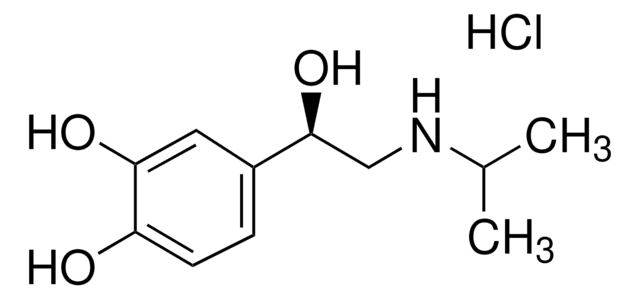369144
2-(Trifluoromethyl)acrylic acid
98%
Sinónimos:
TFMAA
Iniciar sesiónpara Ver la Fijación de precios por contrato y de la organización
About This Item
Fórmula lineal:
H2C=C(CF3)CO2H
Número de CAS:
Peso molecular:
140.06
Número MDL:
Código UNSPSC:
12162002
ID de la sustancia en PubChem:
NACRES:
NA.23
Productos recomendados
Nivel de calidad
Análisis
98%
mp
51-52 °C (lit.)
cadena SMILES
OC(=O)C(=C)C(F)(F)F
InChI
1S/C4H3F3O2/c1-2(3(8)9)4(5,6)7/h1H2,(H,8,9)
Clave InChI
VLSRKCIBHNJFHA-UHFFFAOYSA-N
Aplicación
2-(Trifluoromethyl)acrylic acid (TFMAA) is a strong acid functional monomer, which shows a good performance in the solid-phase extraction of domoic acid. It can also be used in the preparation of molecularly imprinted polymers that show diastereoselectivity for cinchona alkaloids.
Palabra de señalización
Danger
Frases de peligro
Consejos de prudencia
Clasificaciones de peligro
Skin Corr. 1B
Código de clase de almacenamiento
8A - Combustible corrosive hazardous materials
Clase de riesgo para el agua (WGK)
WGK 3
Punto de inflamabilidad (°F)
179.6 °F - closed cup
Punto de inflamabilidad (°C)
82 °C - closed cup
Equipo de protección personal
Eyeshields, Faceshields, Gloves, type P3 (EN 143) respirator cartridges
Elija entre una de las versiones más recientes:
¿Ya tiene este producto?
Encuentre la documentación para los productos que ha comprado recientemente en la Biblioteca de documentos.
Los clientes también vieron
Zhengqiang Dai et al.
Journal of molecular modeling, 21(11), 290-290 (2015-10-27)
Recently, a series of computational and combinatorial approaches were employed to improve the efficiency of screening for optimal molecularly imprinted polymer (MIP) systems. In the present work, we investigated MIP systems based on enrofloxacin (ENRO) as the template molecule and
Ling Zhang et al.
Nature, 557(7703), 86-91 (2018-05-04)
The formation of condensed matter typically involves a trade-off between structural order and flexibility. As the extent and directionality of interactions between atomic or molecular components increase, materials generally become more ordered but less compliant, and vice versa. Nevertheless, high
Porkodi Kadhirvel et al.
Analytical and bioanalytical chemistry, 411(8), 1525-1536 (2019-02-03)
A molecularly imprinted polymer (MIP) was designed in order to allow the selective solid-phase extraction of carbamazepine (CBZ), an anticonvulsant and mood-stabilizing drug, at ultra-trace level from aqueous environmental samples. A structural analog of CBZ was selected as a dummy
Natalia V Beloglazova et al.
Talanta, 190, 219-225 (2018-09-03)
An affinity sensor based on capacitive transduction was developed to detect benzo(a)pyrene (BaP) in river water. Two types of recognition elements, the synthetic receptor analogues molecularly imprinted polymers (MIPs) and natural monoclonal antibody (mAb) were tested for this type of
Junjie Ao et al.
Chemosphere, 199, 98-106 (2018-02-13)
A highly selective sample cleanup method using molecularly imprinted polymers (MIP) was developed for the enrichment of domoic acid (DA, an amnesic shellfish toxin) from both seawater and shellfish samples. Molecular modelling was firstly applied to screening a suitable functional
Nuestro equipo de científicos tiene experiencia en todas las áreas de investigación: Ciencias de la vida, Ciencia de los materiales, Síntesis química, Cromatografía, Analítica y muchas otras.
Póngase en contacto con el Servicio técnico

